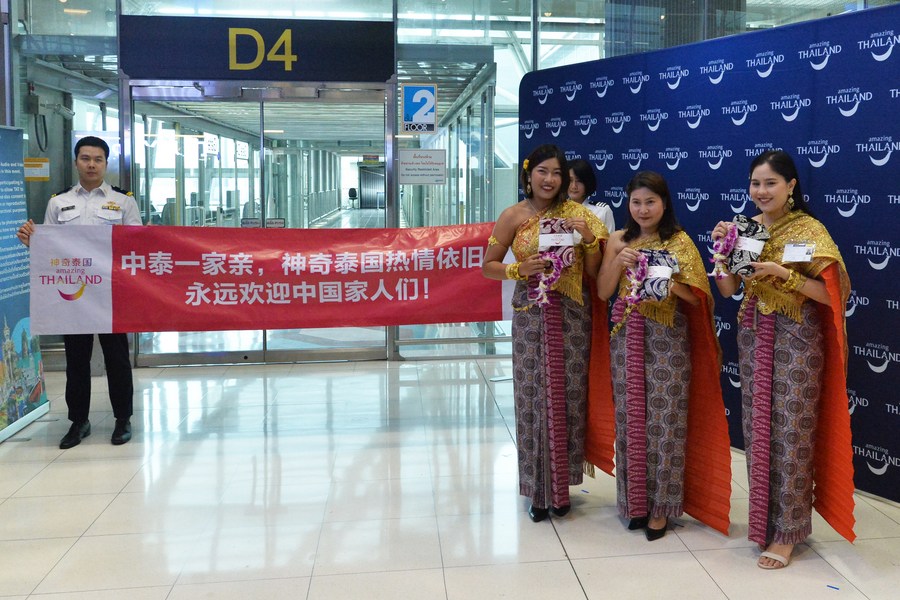BRI participating countries gain popularity among Chinese tourists
Tourism has emerged as a key area for communication and cooperation under the Belt and Road Initiative (BRI). Since the BRI's inception in 2013, participating countries have experienced a surge in tourism exchanges and fruitful cooperation.
This year, as China's outbound tourism market rapidly recovers, BRI participating countries have seen a significant increase in popularity among Chinese travelers.

Staff members prepare to welcome Chinese tourists at Suvarnabhumi airport in Bangkok, Thailand, Sept. 25, 2023. (Xinhua/Rachen Sageamsak)
The search volume for these destinations has risen more than 20 times compared to the previous month in recent days. Notably, BRI countries dominate the list of the top 30 sought-after outbound travel destinations, accounting for over 70 percent of the total.
There has been a marked increase in Chinese tourists' preference for outbound travel destinations in BRI participating countries.
Travel platforms such as Mafengwo, Lvmama, Tuniu, Ctrip, and Tongcheng-eLong have reported a more than 20-fold increase in the overall search volume for outbound travel to BRI participating countries.
This surge can be attributed to various factors, including policy support, favorable visa policies, convenient transportation options, and cost-effectiveness.
The number of Chinese travelers visiting these countries has rebounded to 75 percent of the levels seen during the same period in 2019.
Chinese tourists have shown a strong preference for several BRI participating countries, including Thailand, Singapore, Malaysia, Indonesia, the Philippines, Laos, Vietnam, the United Arab Emirates, Egypt, Russia, and Türkiye.
Notably, Georgia, Serbia, the United Arab Emirates, Qatar, Iran, Saudi Arabia, Kazakhstan, and Uzbekistan have seen rapid growth in both group and customized tours compared to the same period in 2019.
The popularity of overseas destinations is influenced by factors such as visa convenience and flight availability.
BRI participating countries are popular choices for the autumn and winter outbound travel market. Many of these countries have implemented convenient visa policies for Chinese tourists this year.
Georgia, Tunisia, and Kazakhstan have recently offered visa-free entry for Chinese tourists. On Sept. 13, Thailand introduced a visa-free policy for Chinese tourists for a duration of five months, enhancing their willingness to visit.
Within just one week, Lvmama reported a nearly threefold increase in inquiries and bookings for Thailand tour products compared to the previous month, according to Lvmama CEO Zou Qingling.
Zhang Menglei, who oversees holiday products at Tongcheng-eLong, revealed that the number of Chinese tourists visiting the five Central Asian countries, as well as Azerbaijan, Georgia, and Armenia, has surpassed the levels seen in 2019.
Notably, the booking volume for tours to Azerbaijan, Georgia, and Armenia has seen a remarkable increase of over 300 percent compared to the same period in 2019.
Li Mengran, media and public relations manager at UTour Group Co., Ltd., highlighted the improved convenience of visa applications in Central Asian countries. Additionally, the availability of more abundant and flexible flights has further contributed to the development of outbound tourism in the region.
To meet this growing demand, UTour Group Co., Ltd. has introduced a wide range of in-depth tourism products in Central Asia, with durations ranging from a dozen days to over 20 days.
Chinese travel platforms are also expanding their overseas presence.
For instance, Ctrip has established business partnerships with over 70 BRI participating countries. This not only brings Chinese tourists to these destinations but also creates employment opportunities for local communities. Currently, there are more than 1,300 registered local guides in BRI participating countries.
Photos
Related Stories
- China's BRI promotes peace, development, win-win cooperation: Cambodian diplomat, expert
- BRI boosts foreign trade of China's port city
- A vibrant city on ancient Silk Road -- Kashgar in the eyes of foreign tourists
- 'Firsts' achieved under Belt and Road win wide praise
- BRI, GDI unique platforms for promoting youth employment: ILO expert
- Interview: Chilean minister says relationship with China based on complementarity
- China to hold 1st Belt and Road Conference on Science and Technology
Copyright © 2023 People's Daily Online. All Rights Reserved.









